The Mari are a Volga-Ural people who currently live in the Republic of Mari El. This ancient Finno-Ugric people has a rich culture. The article covers one of the branches of Mari culture, namely its ornament and patterns.
Peculiarities of the national culture of the Mari people
Like all Slavic peoples, the Mari have their own national costume, style of its decoration and symbolism of the national ornament. And this pattern on clothes is especially important.
It is one of the most important branches of applied folk art. Its features reflect unique ethnic characteristics, local customs and traditions in the field of art, aesthetic tastes, moral and spiritual principles, as well as the concept of beauty.
Symbolism
Usually real images and motives are transformed and stylized, forming a metaphor based on the nature and life of the people's environment. For example, the symbol of the sun, water means growth, birth, renewal and greatness.
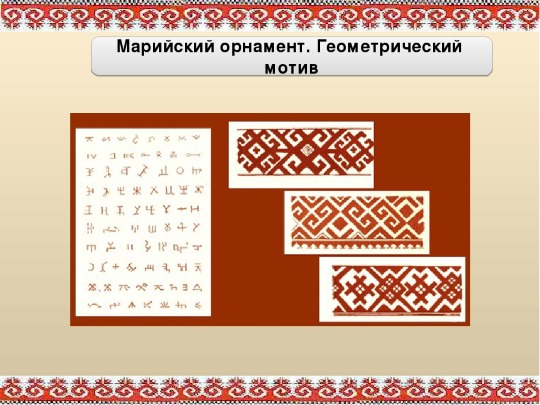
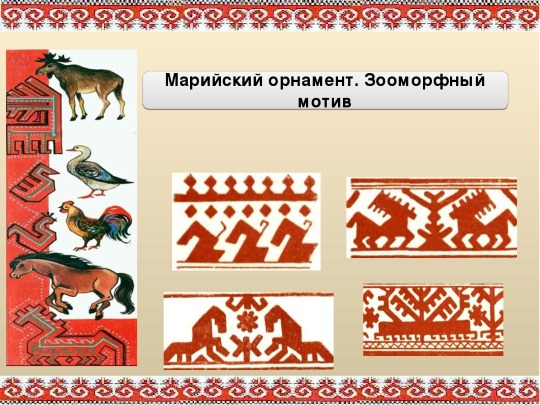
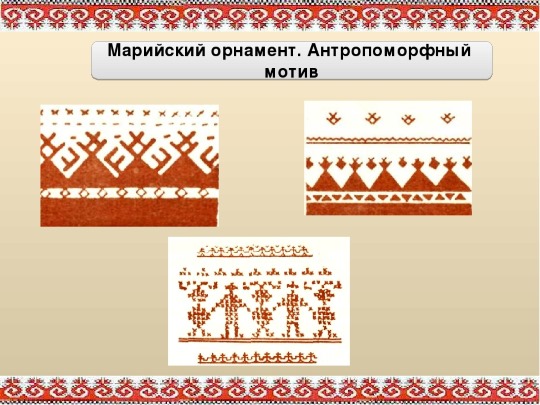
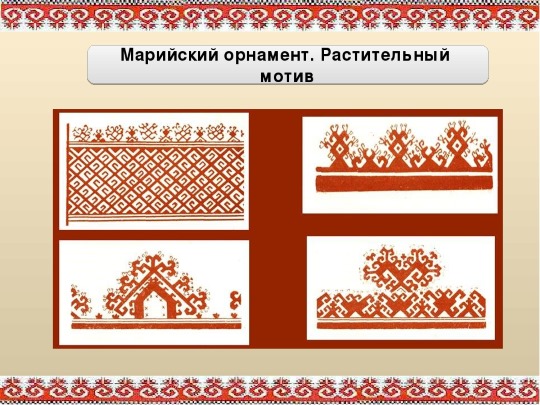
Initially, each hero, image, motif had its own sign:
- The snake, the keeper of the hearth of a married girl, was depicted as a four-pointed cross with curved ends.
- A rhombus or a square with dots crossed crosswise described fertility. Sometimes a rhombus spoke of not the best state of family relations.
- The symbol of the sun, the source of life, was a circle and an octagonal polygon.
- Nature was personified by the figure of a woman with her hands raised to the sky. Where the woman is the manifestation of nature itself, and her hands are its powers, raised to the god Ra - the pagan god of the sun, who blessed and gave permission for various acts of Nature.
- Amulets and helpers in the life of a peasant resident are horses and birds.
- True and pure love - white swans.
- The bird was perceived as a light and vital force.
- A tree, a pair of birds or animals located next to a tree is a sign of family, clan.
- Hard work is like a duck or a grey bird.
- Wealth was symbolized by a horse or a horse.
- Married women wore a slit across the chest, and on both sides of the slit were embroidered paired rosettes called “Guardian of the Breasts,” which protected them from evil forces.
- Mari craftswomen often included a ram's head with horns highlighted in their work. Since this animal was considered sacred by the Mari people, it was depicted on fabric in order to protect themselves from evil spirits and diseases. Deer antlers were a symbol of good luck or a wish for it. Geometric symbols were also relevant.
Mari ornament and patterns - their meaning is reflected in the terminology. For example, a ram's horn was called "taga shur", sickle teeth - "sarla pu", "tserkvy vuy" - this is what the Orthodox cross was called.
Craftswomen sought inspiration in the forms and features of nature. And they described their lives with them, told the story of their homeland, family, village with threads on sarafans and shirts. For example, a rhombus meant that family and personal life were completely in order, a triangle said the opposite.
Mari ornament had the following main motifs:
- geometric patterns;
- zoomorphic patterns;
- anthropomorphic patterns.
Women's and girls' costumes were also often complemented with chest decorations made of coins and beads. This was done because it was believed that the ringing of silver would scare away evil spirits.
How to draw Mari ornament on cells
Mari ornament and patterns depicted on checkered paper are an interesting and simple way for beginners to learn Mari embroidery.

Step by step drawing:
- First, you need to determine the style, meaning and design of the ornament.
- You need to prepare a squared paper, it can be either a notebook or specially lined paper. It depends on the desired size of the ornament.
- And also drawing tools – they can also be different. Basically, it is a pencil. It is most convenient to draw with it. You can use colored and wax crayons, colored pens, markers.
- Next, you need to find some sample on the Internet or in a book and redraw the pattern on paper.
- To get a beautiful and correct drawing, it is necessary to calculate all the cells and be careful when making the product.
How to draw
Before drawing patterns, it is necessary to determine a number of parameters and understand them:
- Purpose (hobby, gift for an event).
- The purpose of the ornament (for clothing, in an album, on a tablecloth).
- Style, meaning (as a talisman, decoration, certain information, description).

- Technique – there are several techniques by which Mari patterns are embroidered and drawn. You need to choose one of them.
- Materials (what the product will be made of and on).
- Appearance. Color, pattern, material are important parts of the process. Depending on the material chosen, the quality of the product will change.
Color is a decisive detail in a drawing. It determines the meaning, mood and character of the ornament. The color palette is also important. The most important features were decorated in red, and its most varied shades were also in the work. Contour lines were decorated in black, and yellow and green shades rarely appeared.
But the main shade for the residents of Mari El was white - the color of kindness and light. Sometimes they added red shades to it, symbolizing the fire of life, strength. And black - for borders.
How to draw the sun
There are many variations of the Mari sun image. Each angle and bend carries certain information. First, you need to learn how to draw the simplest version. There are no specific instructions for depicting the sun in the Mari ornament, but there are some rules and basic provisions that should be followed.
For example, the sun pattern in Mari culture must contain the following elements:
- diamonds or squares;
- geometric twists (similar to a spiral, but angular);
- circles;
- crosses with curved ends;
- octahedral polygons;
- red, white and black colors;
- clear but intricate shape.
By following the following algorithm and including the listed elements in the drawing, you can achieve success.
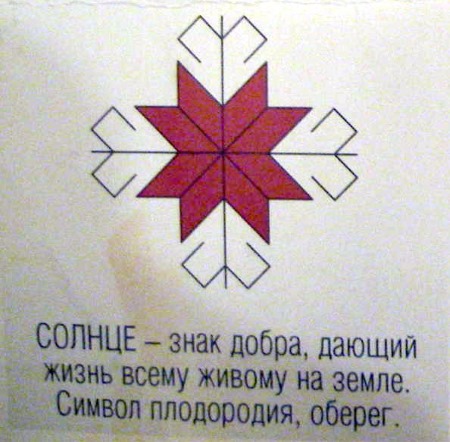
Algorithm for performing work:
- Prepare all the necessary materials (paper, wood, sand, screen and anything you can draw on), as well as all the tools (pencils, paints, pens, cutters).
- The first step in drawing is to draw a diamond or inverted square in the center. It should be filled with red. If desired, you can draw the outline in black.
- Next, draw 2 fairly wide lines parallel to the two sides of the rhombus. Their ends should be bent and facing each other. The lines will have 3 so-called layers. The 1st is the core, highlighted in red. The 2nd is the gap, white, it should be thinner than the previous one. And the 3rd is the frill. It will also be red, but 1 mm thinner than the gap.
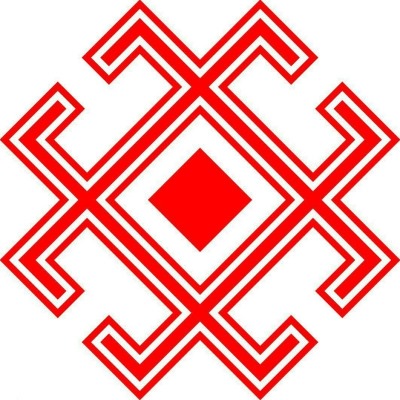
- Now you need to make 2 exactly the same lines, but they will be parallel to the perpendiculars of the previous sides of the rhombus.
- As a result, you should get an inverted square (standing on its edge), enclosed in a second, three-layer inverted square. And from each of its vertices, 2 angles will come out, looking in opposite directions from each other. They will all be three-layered, like the second square. There should be 8 vertices in total.
How to draw background
Mari ornaments and patterns include not only motifs for drawings, but also elements for decorating the base and background. The background of the Mari ornament, as a rule, does not always need to be solid.
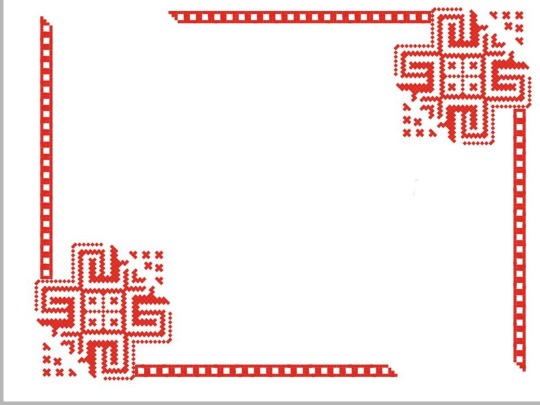
But as a decorative design of the edges of a drawing, clothing, or interior item, this may be a good idea. In any case, the background in the Mari style is several types of patterns connected to each other (their number should not be too large). There are also more complex designs, but they should be approached gradually.
The background says a lot about the object where it is located. It is like a general aura, it tunes the viewer to a certain wave, creates a specific atmosphere. As the main detail from which the background will be created, the sign of the sun, the symbol of Orthodoxy - the cross, fertility and prosperity usually comes out.
To draw a simple background, you need:
- Prepare the necessary materials (usually towels, tablecloths, frames, clothes) and drawing tools. Regular drawing paper will do.
- Decide on the meaning and theme of the future product. In accordance with this, select suitable symbols and signs. In this case, it will be a sign of fertility.
- For convenience, it is better to visually or lightly mark the design boundaries with a pencil.
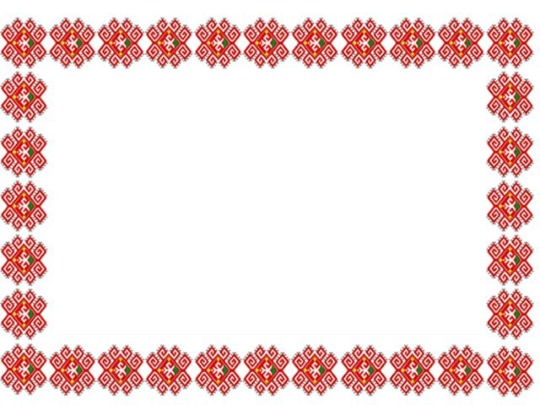
- Now you need to draw the lower border of the ornament in black. This will symbolize the earth, the soil.
- Next, a figure is drawn, like a ladder, it should have 2 small steps going up. A vertical line, then a horizontal one, slightly longer than the previous one, again vertical, the same length as the first one, again horizontal, the same length as the second one, and the first part is completed by another vertical stick.
- Now you need to step back from the edge of the last line to the right approximately as much as the horizontal line was wide. And symmetrically to the previous part, draw the 2nd. That is, at the height of the last vertical line, draw another 1, but with a small indent. Then the drawing goes down in exactly the same ladder. And ends on the lower vertical stick.
- The last part of the element will remain. Where there is space between the first and second parts, a rectangle should be drawn at the bottom. Its support will be the main line - the ground. Then 2 vertical sides, the length of which is the same as on the pyramid. And from above, everything is connected by a horizontal side, the length of which will be correspondingly equal to the horizontal stripes of the pyramid.
- Next, you need to step back a little from the pyramid and draw a vertical line, 2 steps long. Two symmetrical lines should come out of it, and should not exceed the pyramid in height.
- Then you need to step back the same amount from the “tree” and draw a new pyramid, and after it a new “tree” and continue like this along the entire contour.
- The result should be pyramids without a dome, between which there will be figures resembling the letter Y.
Mari patterns on clothes
The Mari preferred to use ornaments in clothing not for decoration, but as amulets. They were embroidered on open areas, the most important or the weakest parts of the body, in their opinion.
They used corresponding symbols – amulets. They were usually placed on the chest, sleeves, belts and headdresses. And also on curtains, pillows, window shutters and decorations.It is best to depict symbols of the sun, birds, swans, and snakes on clothing. All of them serve as powerful amulets against evil and unclean forces.
To draw a pattern on clothes, you should:
- Prepare clothes (in this case, 2 options will be considered - a headdress and a women's shirt).
- Prepare drawing tools.
- For a talisman on a woman's shirt, it is better to take the signs of a rosette, the sun. Drawings of birds and horns.
- It is better to place rosettes and solar signs on the chest section of the shirt and in the chest area.
- Drawings of birds and ram's horns should be placed on the sleeves and belt of the shirt.
- The headdress should be decorated with images of horns and the sun.
Drawings on curtains
Drawings on curtains are a kind of amulet and blessing. In ancient times, it meant a lot. Therefore, it is necessary to prioritize symbols of the sun, signs of birds, ungulates, crosses, squares and rosettes.
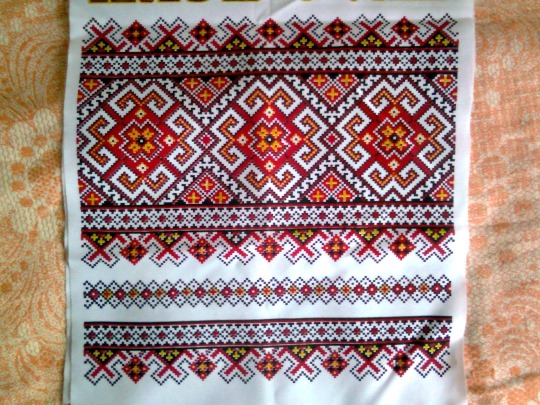
The design can be either on the edges or a full-fledged picture across the entire surface of the canvas. You can use background patterns to decorate the edges, and anything you like for the design itself. It depends on the theme and purpose of the curtain.
If it is located in a hunter's house, it is better to depict deer, ram's horns and solar signs on it. A deer is a symbol of luck. A ram or a bull, or rather their horns, are symbols of blessing and holiness. The sun is a symbol of light and valor.
And if the family of a priest needs new curtains, it is better to depict crosses, the sun, butterflies, trees on them. Crosses are a symbol of Orthodoxy and the Sun - one of the most important gods in the pagan religion. Butterflies are a symbol of purity and divine beauty. Trees are symbols of the connection of two worlds - earth and sky, a sign of the beginning, truth.
Pictures for a frame
Mari ornaments and patterns are not intended for decorating frames, but can be used in this direction.
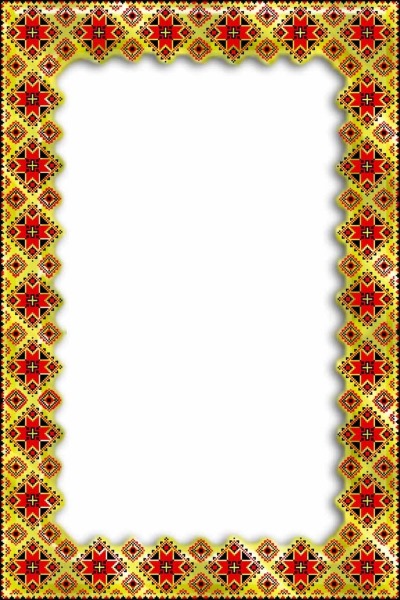
It is best to use background ornaments as a frame pattern. And choosing symbols is a personal matter for everyone, since the background depends on the meaning of the product.
Mari ornaments for embroidery
Mari craftswomen never repeated a single pattern. Each brought her own motif, ideology, and soul to the embroidery. Sometimes the creation of a Mari craftswoman told about her own life, experiences, and history. Due to the enormous potential and long, persistent work of the craftswomen, quite a lot of embroidery techniques, ways of decorating individual details, and manners of work appeared.
For example, "sharpan" - a women's headdress, as well as "kerchiefs" and "shimaksh" had a double-sided pattern. This method had its own technique. It consisted in the fact that the stitching was the same on both sides.
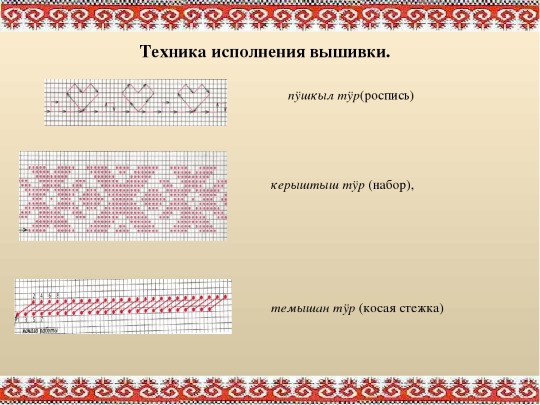
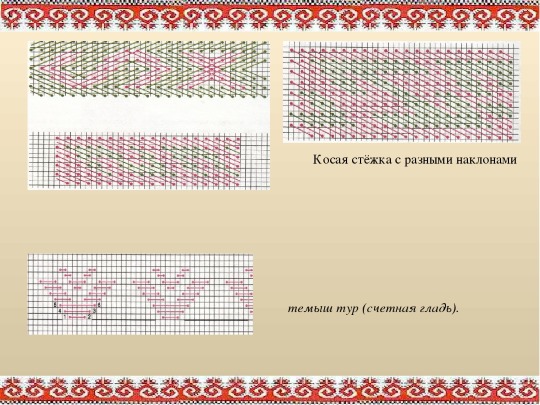
| Name of the technique | The essence of the technique | Application |
| Painting |
| This is a double-sided stitch that creates a pattern with linear stitches, thereby creating an edging for the ornament. |
| Counted satin stitch |
| She was often given "shimakshi" |
| Patterned paths |
| Used to create fine lines in a drawing. |
| Kit |
| It was used for embroidering wedding scarves and shymakshas |
| Bias stitch |
| Used to fill ornamental patterns that already have outlines. This technique can be used for embroidery horizontally, vertically and diagonally, provided that the dimensions are observed. |
Some rarer and simply remaining meanings of Mari embroidery details:
- "Yesh pushe ge" - family tree.

The bigger and brighter the tree, the more prosperous and strong the young family. It looks like a red rhombus with carved curved crosses inside.
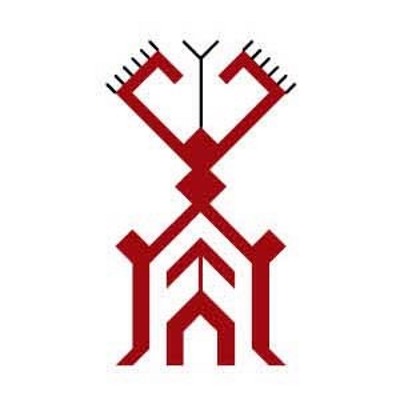
- "Shochinava" - mother. She patronized the young, those who were searching for themselves and learning about life.
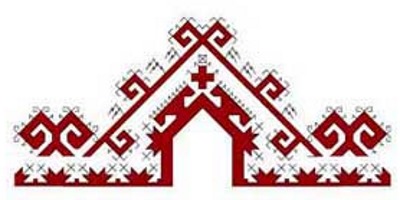
- "Orma" is a talisman of male powers. Means that the man is already mature, ready to create offspring. Looks like a patterned canopy. Red and white colors are present.
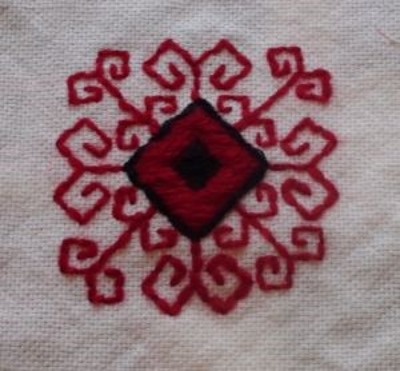
- "Surt Orol" is a home amulet. The house is represented by a square, and there are many amulets inside it – protection from evil forces.
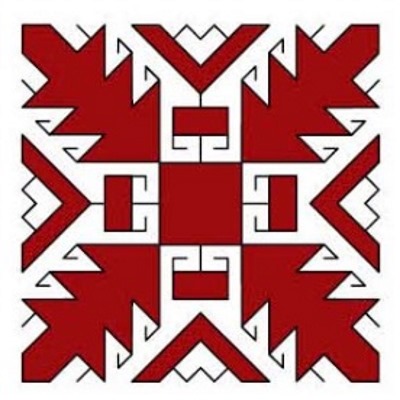
- "Tumo latitaš" - oak or oak leaves. A sign of good health and wealth of strength.
Light Mari ornaments
Beginners can practice simple but beautiful elements:
- Butterfly – a symbol of tender and light feelings, a subtle nature.
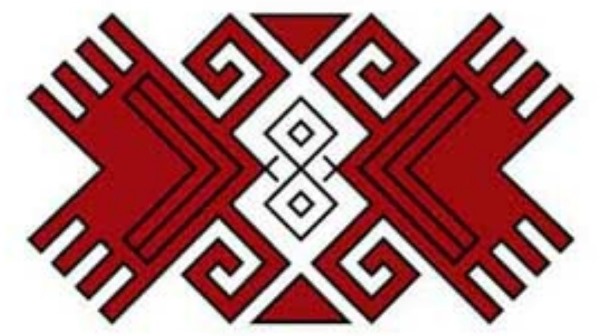
Popular beliefs say that butterflies serve as receptacles for souls, guides to the other world.
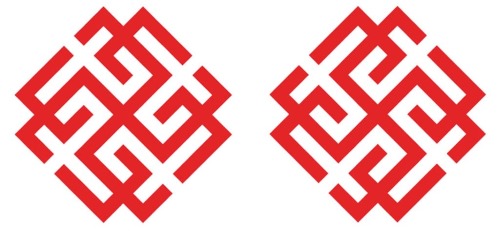
- Sun sign – a talisman, a symbol of goodness and justice.
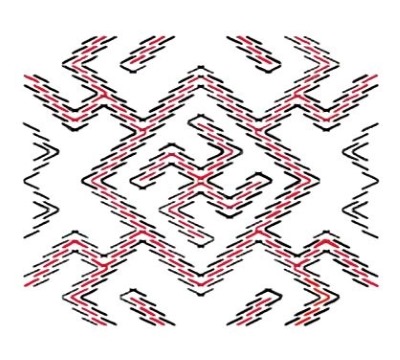
- Swastika – a symbol of true purity and justice. There are many image options, the simplest of which is a cross with curved ends. The embroidery pattern can also be used as a pattern for regular drawing. It is as easy to make as a regular swastika.
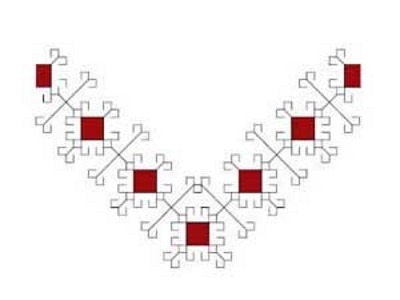
- Chest amulet – a symbol of female strength, maturity, courage and fertility. It also served as a talisman and was embroidered on the collar of a woman’s shirt.
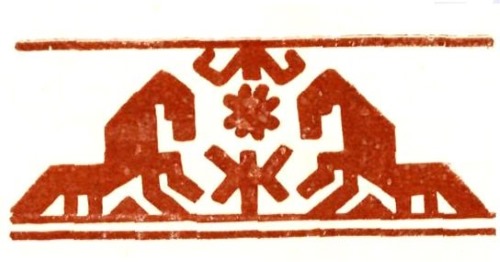
- Horse – a symbol of good luck, prosperity and hard work.
The diverse Mari ornament and beautiful patterns are the heritage of the Russian nation. Being carried away by this activity is a tribute to the national culture. It is not difficult to master the art if you follow special schemes.
Article formatting:Natalie Podolskaya
Video about Mari patterns
Mari ornament, patterns - meaning in embroidery:

Thank you for the information about Mari patterns. I would like to know where you got the material from, what sources did you rely on? I studied traditional folk embroidery, but in the distance course "Traditional Folk Embroidery" I began to collect material about all national embroideries of Russia. The sources must be reliable, the material accurate and truthful. Sincerely, Natalia Bobykina